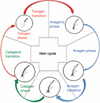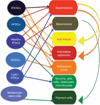Drug discovery for alopecia: gone today, hair tomorrow
- PMID: 25662177
- PMCID: PMC4339524
- DOI: 10.1517/17460441.2015.1009892
Drug discovery for alopecia: gone today, hair tomorrow
Abstract
Introduction: Hair loss or alopecia affects the majority of the population at some time in their life, and increasingly, sufferers are demanding treatment. Three main types of alopecia (androgenic [AGA], areata [AA] and chemotherapy-induced [CIA]) are very different, and have their own laboratory models and separate drug-discovery efforts.
Areas covered: In this article, the authors review the biology of hair, hair follicle (HF) cycling, stem cells and signaling pathways. AGA, due to dihydrotesterone, is treated by 5-α reductase inhibitors, androgen receptor blockers and ATP-sensitive potassium channel-openers. AA, which involves attack by CD8(+)NK group 2D-positive (NKG2D(+)) T cells, is treated with immunosuppressives, biologics and JAK inhibitors. Meanwhile, CIA is treated by apoptosis inhibitors, cytokines and topical immunotherapy.
Expert opinion: The desire to treat alopecia with an easy topical preparation is expected to grow with time, particularly with an increasing aging population. The discovery of epidermal stem cells in the HF has given new life to the search for a cure for baldness. Drug discovery efforts are being increasingly centered on these stem cells, boosting the hair cycle and reversing miniaturization of HF. Better understanding of the molecular mechanisms underlying the immune attack in AA will yield new drugs. New discoveries in HF neogenesis and low-level light therapy will undoubtedly have a role to play.
Keywords: 5-α-reductase inhibitor; alopecia areata; androgenic alopecia; anti-androgen; baldness; chemotherapy-induced alopecia; hair follicle; low-level laser (light) therapy; stem cells; topical immunotherapy.
Conflict of interest statement
The authors have no other relevant affiliations or financial involvement with any organization or entity with a financial interest in or financial conflict with the subject matter or materials discussed in the manuscript apart from those disclosed.
Figures





References
-
- Harel S, Christiano AM. Genetics of structural hair disorders. J Invest Dermatol. 2012;132(E1):E22–E26. - PubMed
-
- Pagel M. What is the latest theory of why humans lost their body hair? Why are we the only hairless primate? Scientific American. 2007
-
- Semalty M, Semalty A, Joshi GP, et al. Hair growth and rejuvenation: an overview. J Dermatolog Treat. 2011;22(3):123–132. - PubMed
-
- The American Hair Loss Association. [Cited 9 January 2015]; Available from: http://www.americanhairloss.org/
-
- Draelos ZK. Hair cosmetics. Dermatol Clin. 1991;9(1):19–27. - PubMed
Publication types
MeSH terms
Substances
Grants and funding
LinkOut - more resources
Full Text Sources
Other Literature Sources
Research Materials
Miscellaneous
